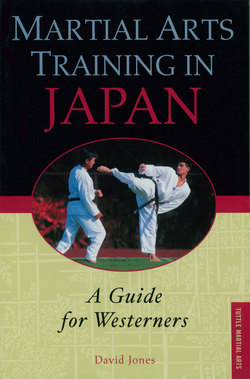Читать книгу Martial Arts Training in Japan - David Jones - Страница 8
На сайте Литреса книга снята с продажи.
ОглавлениеPreface
It is considered acceptable in Japan to ask martial arts teachers about their backgrounds (teachers, credentials, etc.). This is simply reasonable. As you would not put your life in the hands of an unqualified physician, you should not commit your time and money to study with a teacher who cannot demonstrate proof of certification. Martial arts teachers are generally interested, once an acceptable level of familiarity has been reached, in talking about their teachers and the often fascinating history of their ancient styles. Therefore, since this book purports to be a guide to martial arts training in Japan, I thought it would be appropriate that you know your guide’s qualifications. The Japanese word for “teacher” is sensei and, means “born before” or “gone on before”: in short, a guide.
I was awarded shodan (first-degree black belt rank) in aikido in 1973 by Saotome Mitsugi Shihan (master, exemplar), headmaster of the Aikido Schools of Ueshiba. In the spring of 1999 Saotome Shihan promoted me to the rank of godan (fifth-degree black belt). I was ranked to nidan (second-degree black belt) by Thomas Cauley Shihan, United States director of Sakugawa Koshiki Shorinji-ryu karatedo. In 1988-89, while teaching in Fukuoka, Japan on a Fulbright scholarship, I was promoted to shodan in Muso-ryu jodo, testing before Otofuji Shihan, then headmaster of the ryu (school, or style). At the Fukuoka Budokan I practiced kyudo (traditional Japanese archery) under Asakuma Hanshi (eighth-degree black belt) and was promoted to the rank of shodan after formal testing.
I have written a number of articles and presented numerous research papers at various anthropological conventions and meetings (the annual meeting of the American Anthropological Association, annual meeting of the Central States Anthropological Society, and the annual meeting of the Southwestern Anthropological Society) on various aspects of Japanese martial arts. My book Women Warriors (Brasseys, Inc.: McLean, Virginia, 1997) is a study of the worldwide female martial tradition. In addition, I was asked to contribute the foreword to Saotome Mitsugi Shihan’s first book, Aikido and The Harmony of Nature. My tai chi ch’uan (Supreme Way of the Ultimate Fist) instructor, Chan Poi Sifu, grandmaster of Way Lum Praying Mantis kung fu, also asked me to write the foreword to his book, The Fatal Flute Form.
I have been teaching the martial arts aikido, Shorinji-ryu karatedo, and tai chi ch’uan for fifteen years. Presently I teach aikido two days a week at the University of Central Florida, where I am a professor of cultural anthropology, and two days a week at the Shin Dai Aikikai in Orlando, Florida, the largest aikido training facility in the area.
During my time in Japan I also trained in Komuso Zen (a Zen Buddhist sect whose name translates as “the followers of emptiness” or literally “emptiness, nothingness, priest”) at Saikoji, a small temple on the grounds of Shofukuji in Fukuoka which is one of the most ancient Zen temples in Japan. The Komuso monks, easily identified by a helmet-like basketry hat (tengai) and the large bamboo flutes (shakuhachi) which they play as they wander on their alms-seeking rounds (takuhatsu), have a history that interestingly intertwines with that of the samurai, many of whom joined the Komuso and indelibly stamped it with their character.
My anthropological research has touched upon not only warfare and martial arts, but also religion, law, cross-cultural studies of education, and social control.
I have decided to write this guidebook in the first person, because if it is to be true to the essence and spirit of traditional martial arts practice in Japan, we have to come to know one another as best we can, even through the screen of the printed page. I will share my personal experiences of studying in Japan with you because, at least in broad outline, they will shortly become your experiences, too. Further, I will offer information of a practical nature regarding fees, finding a dojo, and practice schedules at various Japanese dojo, as well as cultural and historical materials pertaining to Japanese martial arts which one needs to be mindful of while training in a Japanese dojo.
The Japanese tale “Rashomon” provides classic insight into the various ways the same events are seen by different witnesses. I can only give you my reading on what I did and what I saw. My opinion sometimes differed from other Westerners. Some facets of budo training which I found to be boring, others found “Zenlike.” What I considered to be the sadistic behavior of some sempai (senior students) others said was “hard training.” Some of the experiences I found sublime—Zen, kyudo, jodo—others found “empty” and unproductive.
I have introduced myself to you by noting my various martial arts ranks—gifts from my generous teachers to this frail, awkward college professor—and though we cannot bow to each other in polite recognition, we have probably met and shared a moment of peace and harmony—sparring, perhaps. Maybe we were at the same seminar practicing basics under the critical eye of some noted sensei until we were ready to drop, dripping sweat, lungs heaving. Maybe we bumped elbows at the martial arts store looking over the latest books. Maybe we critically eyed each other in the kata competition at one of the local tournaments. I salute you and I envy you. You are on your way to Japan!
